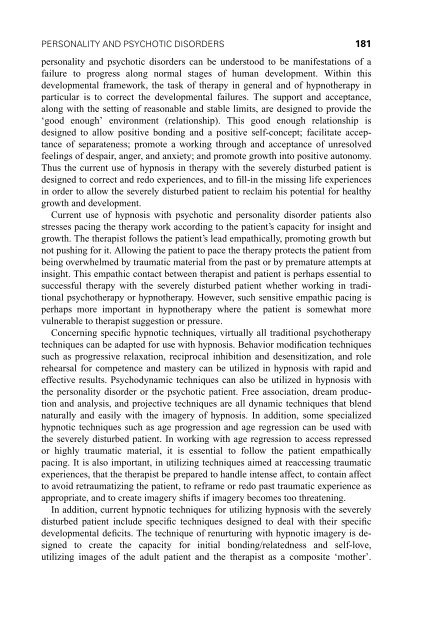International Handbook of Clinical Hypnosis - E-Lib FK UWKS
International Handbook of Clinical Hypnosis - E-Lib FK UWKS
International Handbook of Clinical Hypnosis - E-Lib FK UWKS
Create successful ePaper yourself
Turn your PDF publications into a flip-book with our unique Google optimized e-Paper software.
PERSONALITY AND PSYCHOTIC DISORDERS 181<br />
personality and psychotic disorders can be understood to be manifestations <strong>of</strong> a<br />
failure to progress along normal stages <strong>of</strong> human development. Within this<br />
developmental framework, the task <strong>of</strong> therapy in general and <strong>of</strong> hypnotherapy in<br />
particular is to correct the developmental failures. The support and acceptance,<br />
along with the setting <strong>of</strong> reasonable and stable limits, are designed to provide the<br />
`good enough' environment relationship). This good enough relationship is<br />
designed to allow positive bonding and a positive self-concept; facilitate acceptance<br />
<strong>of</strong> separateness; promote a working through and acceptance <strong>of</strong> unresolved<br />
feelings <strong>of</strong> despair, anger, and anxiety; and promote growth into positive autonomy.<br />
Thus the current use <strong>of</strong> hypnosis in therapy with the severely disturbed patient is<br />
designed to correct and redo experiences, and to ®ll-in the missing life experiences<br />
in order to allow the severely disturbed patient to reclaim his potential for healthy<br />
growth and development.<br />
Current use <strong>of</strong> hypnosis with psychotic and personality disorder patients also<br />
stresses pacing the therapy work according to the patient's capacity for insight and<br />
growth. The therapist follows the patient's lead empathically, promoting growth but<br />
not pushing for it. Allowing the patient to pace the therapy protects the patient from<br />
being overwhelmed by traumatic material from the past or by premature attempts at<br />
insight. This empathic contact between therapist and patient is perhaps essential to<br />
successful therapy with the severely disturbed patient whether working in traditional<br />
psychotherapy or hypnotherapy. However, such sensitive empathic pacing is<br />
perhaps more important in hypnotherapy where the patient is somewhat more<br />
vulnerable to therapist suggestion or pressure.<br />
Concerning speci®c hypnotic techniques, virtually all traditional psychotherapy<br />
techniques can be adapted for use with hypnosis. Behavior modi®cation techniques<br />
such as progressive relaxation, reciprocal inhibition and desensitization, and role<br />
rehearsal for competence and mastery can be utilized in hypnosis with rapid and<br />
effective results. Psychodynamic techniques can also be utilized in hypnosis with<br />
the personality disorder or the psychotic patient. Free association, dream production<br />
and analysis, and projective techniques are all dynamic techniques that blend<br />
naturally and easily with the imagery <strong>of</strong> hypnosis. In addition, some specialized<br />
hypnotic techniques such as age progression and age regression can be used with<br />
the severely disturbed patient. In working with age regression to access repressed<br />
or highly traumatic material, it is essential to follow the patient empathically<br />
pacing. It is also important, in utilizing techniques aimed at reaccessing traumatic<br />
experiences, that the therapist be prepared to handle intense affect, to contain affect<br />
to avoid retraumatizing the patient, to reframe or redo past traumatic experience as<br />
appropriate, and to create imagery shifts if imagery becomes too threatening.<br />
In addition, current hypnotic techniques for utilizing hypnosis with the severely<br />
disturbed patient include speci®c techniques designed to deal with their speci®c<br />
developmental de®cits. The technique <strong>of</strong> renurturing with hypnotic imagery is designed<br />
to create the capacity for initial bonding/relatedness and self-love,<br />
utilizing images <strong>of</strong> the adult patient and the therapist as a composite `mother'.











![SISTEM SENSORY [Compatibility Mode].pdf](https://img.yumpu.com/20667975/1/190x245/sistem-sensory-compatibility-modepdf.jpg?quality=85)





